| |
|
|
|
|
| |
Related Stories |
|
|
|
| |
|
|
|
|
| |
WaldAktion BC |
|
Kahlschlag in Kanada |
|
| |
Bear Mountain Treesit |
|
Save the Klaskish Giant and East Creek |
|
| |
Sooke Potholes Forest Destoyed |
|
Haida Nation v. BC & Weyerhaeuser |
|
| |
Stop Killing Big Trees |
|
We Need a Paper Revolution! |
|
| |
MacMillan Park Stumpfield |
|
Spirit Bears and Rainwolves in Germany |
|
| |
European Tree of the Year |
|
Parking in the Cathedral |
|
| |
Viva Touristika Rostock |
|
Colleen McCrory (1950 - 2007) |
|
| |
Koksilah River Big Trees |
|
Muir Creek Big Trees |
|
| |
|
|
|
|
| |
|
|
| |
|
|
|
|
| |
Haida Nation v. BC & Weyerhaeuser
The Haida Nation celebrated a landmark legal victory in Ottawa (right) over the continued exploitation by
BC and Weyehaeuser of the natural resources on Haida Gwaii, including old growth cedar: "On 18 November 2004 the
Supreme Court of Canada released its long awaited decision in the Haida Nation versus British Columbia and Weyerhaeuser
case. The Haida had challenged the Minister of Forests' decision to replace a Tree Farm Licence (TFL 39), an exclusive
forestry tenure that covers one quarter of the land base of Haida Gwaii, the homeland of the Haida Nation. Logging
in TFL 39 has exceeded sustainable rates for years and old growth cedar, an integral material in Haida culture,
is becoming extremely rare. The streams that support salmon and other fish have also been harmed" Eagle Law.
|
|
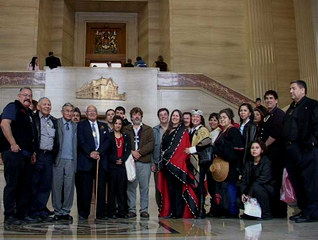 Haida victory, Supreme Court, 2004
Haida victory, Supreme Court, 2004
Photo: Haida Nation |
|
| |
|
|
 |
|
| |
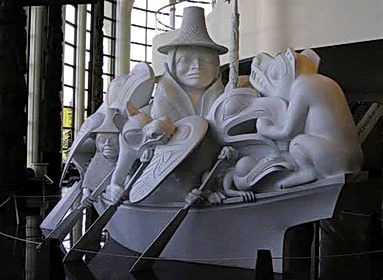
"Spirit of Haida Gwaii," Scupture by Bill Reid.
Canadian Museum of Civilization |
|

$20 Canadian bill with Haida motifs.
Bill Reid Foundation
The Haida people are well known for their magnificent works of art on view at the
Canadian Museum of Civilization such as Bill Reid's "Spirit of Haida Gwaii" (left) which is portrayed on
the Canadian $20 bill (above) along with his "Raven and the First Men" sculpture in yellow cedar. |
|
| |
|
|
 |
|
| |
As a result of the landmark 2004 Haida TFL 39 Case, the
Haida Nation was able to turn the tables on Weyerhaeuser, an action that resulted in the American logging
giant abandoning its operations on Haida Gwaii. A b component of the Haida's legal case against Weyerhaeuser
was the corporation's rampant excessive logging of ancient red cedar, a vital aboriginal heritage tree.
Everywhere on Haida Gwaii, the use of monumental cedar in traditional culture is evident, from half finished
canoes (right) in the forests to totem poles lining the beaches. The Supreme Court of Canada's ruling means that
sustainable indigenous forest management on Haida Gwaii is allowed to continue.
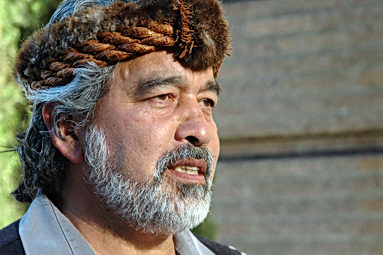
Haida Nation leader Guujaaw, 2006.
Photo: EcoTrust |
|
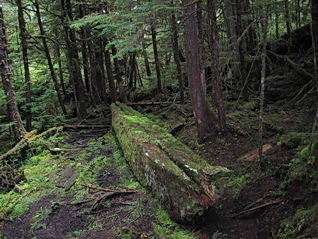
Haida canoe relic of an ancient red cedar.
Haida Gwaii
Guujaaw, president of the Haida Nation: "The Court made it clear that the status quo would have to
change, and that it was not honourable for the Crown to run roughshod over the rights and interests of the Haida. The legal
principles articulated by the court created opportunities to reconcile Haida and Crown title through new models for long term
sustainability in Haida Gwaii. . . The Court ruling represents an obligation which is the best chance for the well being and
sustainability of the land." In 2006 EcoTrust honoured Guujaaw (left) for his environmental and economic
initiatives on Haida Gwaii. |
|
| |
|
|
 |
|
| |
|
|
| |
|
|
|
|
| |
We Need a Paper Revolution!
"Papierwende" is a travelling photographic exhibition on paper consumption in Germany (right). It reaches out to schools and
communities with the environmental battlecry "We Need a Paper Revolution!" The educational exhibition
is travelling across Germany as part of a campaign organized by local environmental groups and supported by the
federal government. Germany is the world's third largest consumer of paper in the world and the campaign aims
to teach people how to reduce their paper consumption and why they should use only 100 percent recycled post
consumer paper. In conjunction with the Goettingen exhibition lectures were given describing how the high
German consumption of paper threatens the indigenous peoples and their forests in countries such as
Indonesia, Canada and Brasil. |
|
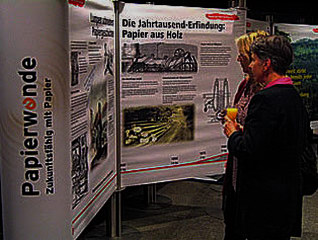 Paper consumption exhibit, Goettingen.
Paper consumption exhibit, Goettingen.
Photo: Stephan Roehl |
|
| |
|
|
 |
|
| |
"Papierwende" Exhibition on Paper Consumption in Germany (Click photos to enlarge) |
|
| |
|
|
| |
|
|
 |
|
| |
|
|
| |
|
|
|
|
| |
Spirit Bears and Rainwolves in Germany
Germans understand the importance of ecosystems in supporting wildlife. Klaus
Pommerenkes published a book on the rainforest of the white bear in 2009 (right). Its subtitle,
"Ein bedrohtes Ökosystem," calls this ancient rainforest on the Pacific coast of Canada,
an "endangered ecosystem." Illustrating the text are stunning nature photos taken by the
author. A wide range of important environmental issues that threaten this rainforest, since 2009 officially
known as the "Great Bear Rainforest," include trophy hunting, over-fishing of wild salmon, fish
farms, the logging industry, and threats caused by oil and gas pipelines and coastal transport. Many
useful maps also illustrate the text and show how the habitat or "Lebensraeume" of the great
predator species is constantly shrinking due to resource extraction. |
|
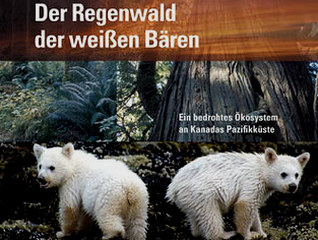 Cover of a book on the Great Bear Rainforest
Cover of a book on the Great Bear Rainforest
Klaus Pommerenke, 2009 |
|
| |
|
|
|
|
| |
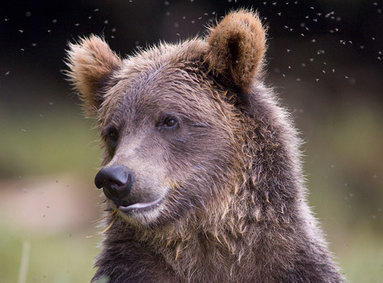
Grizzly bear, Great Bear Rainforest.
Photo: Klaus Pommerenkes |
|
The BC government has invested much effort in advertising its
newly designated Great Bear Rainforest as a major nature protection initiative. Due to
gag orders on the environmental groups who negotiated the deal, few dissenting voices
are heard despite the fact that many activists view it as an environmental sell-out and
fraudulent scam. The German activists who were prominent during the market campaign in
Europe have an astute understanding of the devastating compromises made to industry
under the cover of greenwash. See the discussion of the discredited FSC (Forest
Stewardship Council) and EBM (Ecologically Based Management) schemes on the German website:
NaturSchatz.
The European Union has banned the import of grizzly bear trophies and it is hoped that old growth cedar
pulp and lumber products will soon follow. |
|
| |
|
|
|
|
| |
It is time for Euro Americans to reconsider their antagonistic relationship to wolves;
reviled as predators, wolves have been long been misunderstood, persecuted and threatened. Raincoast Conservation
Society's film "Rainwolves" (right) was presented in
Goettingen, Germany at the Institute for Scientific Film during a 2004 symposium on "Moving Images in Life
Sciences." The film provides rare documentary footage of native BC wolves fishing for salmon in the
temperate rainforest, digging for clams, and swimming from island to island while hunting. Importantly,
"Rainwolves" covers habitat loss and other threats faced by the wolves. By recording the vanishing
primaeval coastal wilderness of the so-called "Great Bear Rainforest," the film exposes the ever
present danger of transnational logging, mining and energy corporations in search of increasingly scarce
natural resources even in an area that is supposedly protected. |
|
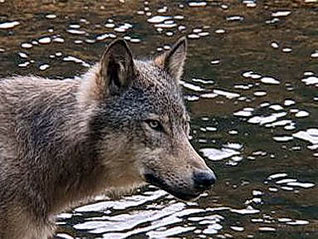
Screenshot from Rainwolves.
Raincoast Conservation Society |
|
| |
|
|
 |
|
| |
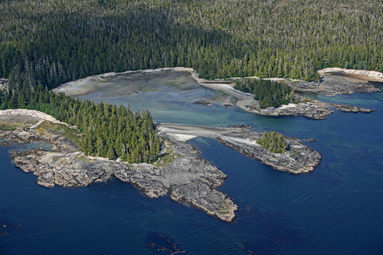
Great Bear Rainforest, British Columbia, 2006.
Photo: Sevilla
Wolves in BC are not only losing their habitat due to resource exploitation but
they are the victims of a colonialist mentality aimed at eradicating predators to increase elk and other big game
animals for sport hunting. Thus wolves continue to be hunted, trapped, poisoned and
sterilized in a hidden war conducted by the government (right). See: Trophy Hunting of BC Grizzly Bears (Pacific Wild). |
|
"Rainwolves – From Obscurity to Renown" is
the first study of coastal wolves concerned with evolutionary, ecological and conservation oriented questions
such as: "Are wolves on the coast genetically unique? How might hunting by humans affect genetic diversity?
On which resources do wolves depend, and how does logging affect this predator prey system? How does an archipelago
system influence gene flow among landmasses?"
Raincoast Conservation
Society.
|
|
| |
|
|
 |
|
| |
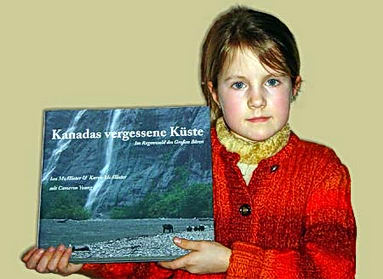
Tree ring contest winner, Rostock, 2005.
"Kanadas vergessene Kueste"
In 2007 Ian McAllister published his book "The Last Wild Wolves" (right) in which he documents
the behaviour of two wolf packs, one in the extreme outer coastal islands of BC and another more inland.
The photos by McAllister show the animals catching salmon, stalking seals, playing on the beach and raising their
young. Scientific research and traditional indigenous knowledge substantiate that these wolves are genetically
distinct; "unlike other wolves, they subsist on coastal prey and swim from island to island in their archipelago
home." MacAllister's book stresses the need to preserve the Great Bear Rainforest as one of the last coastal wildernesses
in North America where wolves and grizzly bears live relatively undisturbed by humans. |
|
A founding member of the Raincoast Conservation Society
is Ian McAllister, whose first book, The Great Bear Rainforest (1997), was instrumental in bringing the need to protect
the coastal BC wilderness to public attention. Translated into German as "Kanadas vergessene Kueste," it has also been important to raising the
awareness in Germany of the endangered wildlife species and their habitats. A copy of the book was won by a young
German girl (left) during a tree ring counting contest organized by AKU to educate the public about the disastrous
forest policies in Canada:
AKU
auf Touristikmesse.
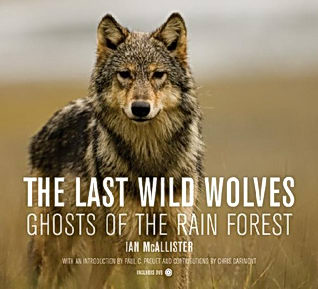
The Last Wild Wolves, 2007.
Ian McAllister, Pacific Wild |
|
| |
|
|
|
|
| |

Rainwolf pup, Great Bear Rainforest, 2008.
Photo: Ian McAllister |
|
On 1 April 2008 Ian McAllister released a statement
accusing the BC government of failing to protect the Great Bear Rainforest. The 2006 eco based land use agreement
that promised to establish new conservancy boundaries remains unlegislated. Instead new large scale industrial
proposals are planned such as wind farms on Banks Island Conservancy and the flooding of lake systems in the Nascall
Conservancy. Furthermore the Spring Trophy Hunt opens across BC on 1 April, encouraging big game hunters to kill for sport wolves,
grizzly bears and black bears, including bears with the recessive gene found in the endangered BC Spirit Bear,
the mascot of the Great Bear Rainforest conservation movement. "Flooded rivers, dead bears and massive wind
farms are not what the people of the world were promised" Ian McAllister: PacificWild. |
|
| |
|
|
 |
|
| |
|
|
| |
|
|
|
|
| |
Parking in the Cathedral
The BC government organized a surprise public meeting to discuss Cathedral Grove on 25
October 2004 in Port Alberni. Despite the short notice, those present included Hupacasath Chief Councillor
Judith Sayers, Western Canada Wilderness Committee and the Friends of Cathedral Grove (FROG). The government's
parking lot plan was rejected by the public in favour of the long standing proposal that has been under review
for 30 some years to reduce traffic congestion in Cathedral Grove by rerouting Highway 4 via a new connector
road from Port Alberni and Horne Lake to the east coast of Vancouver Island. FROG submitted an alternative plan
which uses an existing clearcut area (right). This area is located close to Cathedral Grove so that none of the
existing forest buffer need be sacrificed:
Parking Lot Solution. |
|
 Cathedral Grove Parking Solution
Cathedral Grove Parking Solution
Friends of Cathedral Grove
|
|
| |
|
|
 |
|
| |

Speeding log truck from Port Alberni.
Cathedral Grove, Vancouver Island |
|

Highway parking, 2006.
Cathedral Grove, Vancouver Island
The real problem is not caused by tourists parking in Cathedral Grove (above),
but by the large volume of commercial trucks transporting raw logs and lumber from Port Alberni through
the popular big trees park at excessive speeds (left). |
|
| |
|
|
|
|
| |

Forest protection camp, Cathedral Grove, 2004.
Photo: Ingmar Lee
Public safely issues caused by the high level of traffic through Cathedral Park and
lack of parking facilities are red herrings used by the government to distract attention from the true
underlying problems. The message of the 2004 forest defence action in Cathedral Grove was clear:
Weyerhaeuser Go Home! (right). Old growth logging in BC must be banned; Cathedral Grove must be expanded; and
the highway through it rerouted. Instead this irreplaceable natural heritage is being mismanaged by park authorities who
are subjecting the precious ecosystem – which is already severely damaged due to human intervention –
to short term economic profit schemes including a 200 car parking lot, a restaurant and a souvenir shop. Meanwhile
the real culprits (Island Timberlands, Brookfield, Brascan, Weyerhaeuser, MacMillan Blodel) who have destroyed the
Cathedral Grove Watershed and removed the buffer zone protecting the big trees are going without punishment. |
|

"Weyerhaeuser Go Home," 2004.
Photo: Krista Roessingh |
|
| |
|
|
 |
|
| |
|
|
| |
|
|
|
|
|
Colleen McCrory (1950 - 2007)
The sudden and unexpected death of 57 year old Colleen McCrory on 1 July 2007
has left the BC environmental movement without a leader. Colleen was one of the founders of a grassroots
environmental group based in the small town of New Denver on Slocan Lake in the Kootenays area of
southeastern BC:
Valhalla Wilderness Society.
Colleen McCrory was born and raised in the East Kootenays, the daughter of a placer miner,
and her love for the wilderness and its wildlife inhabitants inspired in the 1980s her first battle to protect
the Slocan Watershed from the voracious clearcut logging that has devastated so much of the Kootenays.
While she was in Berlin, Germany in 2004 to attend the 25th anniversary party of the
German Greens, Colleen McCrory lobbied for the wildlife of BC (right). |
|
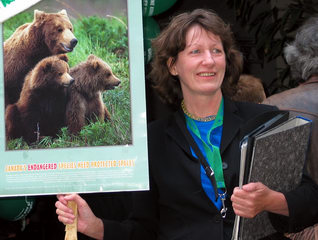 Colleen McCrory, Berlin, 2004
Colleen McCrory, Berlin, 2004
Photo: Karen Wonders
|
|
| |
|
|
 |
|
| |

Eva Quistorp and Colleen McCrory, Berlin, 2004.
Photo: Stephan Roehl
AKU (ArbeitsKreis
noerdliche Urwaelder) is a German forest activist network that supports the
mountain caribou protection campaign by the Valhalla Wilderness Society:
Schiessen
statt Schuetzen. Toby Spribille, a lichenologist at Goettingen University with some 4,000 specimens in his collection, believes that BC's
inland rainforest may well have the greatest biodiversity in the northern hemisphere.
In 2006 he published a scientific paper on the 13 new lichen species dependent on old growth forests that his
research group had discovered and named:
Inland Rainforests. |
|
Kahlschlag in Kanada Colleen McCrory often lobbied in Europe and she was well known to European nature campaigners.
In 2004 she visited Germany to draw attention to the lack of representation of Green voters in BC, and seek support
for BC's environmentalists: Canadian Green Activist Appeals to German Greens: WaldAktion BC (Naturschatz). In Berlin, Colleen met Eva Quistorp (left), a founding member of the German Greens and the Green German
Minister of the Environment:
Juergen Trittin
(below).
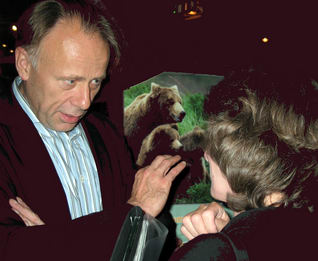
Trittin and McCrory, Berlin, 2004.
Photo: Stephan Roehl |
|
| |
|
|
 |
|
| |
One of Colleen McCrory's last acts of nature protection was the Selkirk
Mountain Caribou Park Proposal. Anne Sherrod, president of the Valhalla Wilderness Society, wrote
the BC premier: "Colleen spent the last nine years of her life calling attention to the value of the
old growth Inland Temperate Rainforest and trying to save its endangered mountain caribou. She was
extremely upset that old growth forest continued to be logged even while the mountain caribou was
struggling to survive. She was outraged that the recovery process for mountain caribou had been
going on for over three years with no definitive result" (6 July 2007).
BC's inland temperate rainforest has 98 percent of the world's surviving mountain caribou.
In 2007, 42 scientists signed a petition demanding the protection of the species from the wood products
industry: "One can kill animals quickly with a gun, or slowly by destroying their habitat. The mountain
caribou are on the slow road to extinction and we are killing them. Their best chance and only chance of
survival is to protect the last remaining old growth." |
|
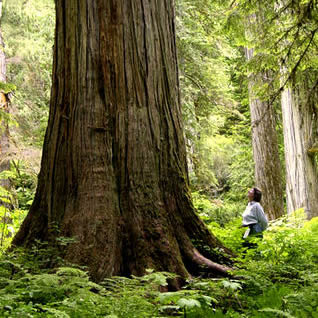
Colleen McCrory with big cedar.
Photo: Valhalla Wilderness Society |
|
| |
|
|
 |
|
| |
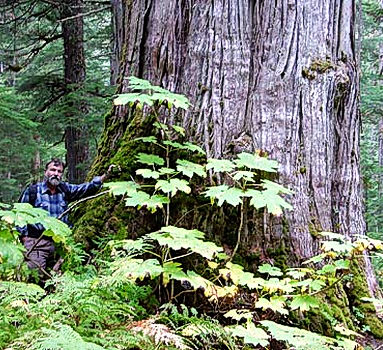
Ancient Inland Rainforest cedar.
Photo: Valhalla Wilderness Society |
|
Joan Russow, former leader of the Green Party of Canada,
writes about Colleen McCrory: "Since spending time with her in 1992 at the UN Conference on Environment and
Development held in Rio de Janerio, and through years of being aware of and appreciating her leadership in the
environmental movement in British Columbia, I was always impressed with her unwavering passion for the environment,
her astute analysis of the politics surrounding the environment, and her enduring commitment to the need to find
environmental solutions in the interdependence of international, national and regional environmental issues. Who
can forget the power of her coining the phrase 'BC is the Brazil of the North.'"
To honour Colleen McCrory, in 2006 the Valhalla Wilderness Society called for a moratorium on
all old growth logging in the Inland Rainforest. To support this important initiative, the German environmental
network AKU held a demonstration in Berlin in 2007. See:
Bedrohte
Urwaelder. |
|
| |
|
|
|
|
| |
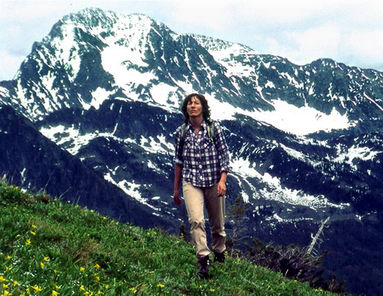
Colleen McCrory hiking, Selkirk Range.
Photo: Valhalla Wilderness Society
Gitxsan Chief Mas Gak: "Colleen was a staunch supporter of the Degalmuukw
Title Action from start to finish. The Gitxsan will never forget her and what she has done to protect
the spirit in the land. Walk on, walk on, Colleen. There is happiness and laughter at the campfires of
our ancestors." |
|
In Norse mythology, "Valhalla" refers to a
warrior's heaven. The mountain wilderness in the Kootaneys that Colleen McCrory helped to protect will forever attest to
her passion and dedication as an environmental activist. Today her memory is best honoured by continuing the urgent
preservation battle to save the ancient inland temperate rainforest of the Selkirk Range.
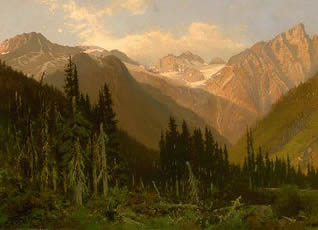
"Summit of the Selkirk Range."
Painting by John A. Fraser, 1886 |
|
| |
|
|
 |
|
| |
|
|
| |
|
|
|
|
| |
Muir Creek Big Trees
Muir Creek is a salmon stream surrounded by old growth fir, cedar, maple and
Sitka spruce located in the traditional territory of the
T'Sou'ke First Nation on the
southernmost end of Vancouver Island (right). A small number of the spectacular native big trees at Muir Creek have
survived the past 50 years of industrial logging. The second largest yew tree in the BC Big Tree Registry grows
at Muir Creek, and up to ten other trees may qualify for the registry once their heights have been measured. Yet today these
rare and endangered big trees are being targeted for helicopter logging by TimberWest, an unscrupulous lumber company
with a long record of ancient forest destruction. Community members have begun an urgent initiative to save the trees
and preserve the lower part of Muir Creek. |
|
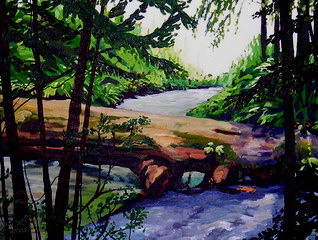 Fallen Giant at Muir Creek
Fallen Giant at Muir Creek
Watercolour by Ravens Home |
|
| |
|
|
 |
|
| |
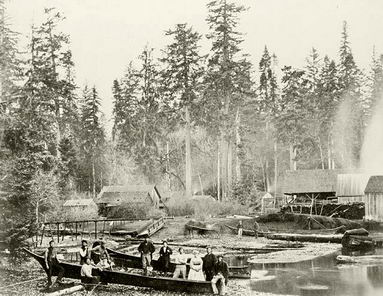
"Indian canoes," John Muir Sawmill, c. 1860.
Photo: Archives Canada
Muir Creek was one of the first sites in the new British colony to be claimed by settlers.
It was named for a Scottish coal miner, John Muir (right), who had arrived in Victoria in 1850 when it was still
a fur trading fort. In 1860 Muir set up a sawmill further along the coast, where he could prosper by cutting down
the huge Douglas firs. This was an aboriginal site traditionally used by T'Sou'ke people for winter dancing and
smoking fish. The John Muir Sawmill was the first steam sawmill in the new colony; a c. 1860 photo (above) of it
includes a group of settlers posed around two traditional Coast Salish dugout canoes, remarkable vessels carved by the
indigenous peoples from massive red cedar trees.
The Muir Sawmill supplied Muir's lumber yard in Victoria from 1860 until 1892. Muir also
started the largest privately owned fleet of ships on the Northwest Coast and became a magistrate and member of
the first Legislative Assembly of Vancouver Island. Clearly the Scottish settler found success and prosperity
in the new colony and he must have known of and perhaps taken part in the 1883 Dunsmuir Land Grab. |
|
In 1883 23 percent
of Vancouver Island, mostly forest lands never before harvested, including the area around Muir Creek, became
part of a corrupt land grab by Robert Dunsmuir, a Scottish coal baron and early settler. The land was not ceded by its
indigenous Coast Salish inhabitants, yet it fell into the hands of a succession of lumbermen such as H. R. MacMillan
all of whom made private fortunes by destroying the primaeval forests.
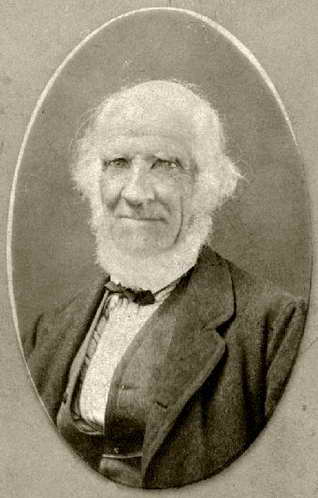
John Muir, 1849.
Photo: BC Archives |
|
| |
|
|
 |
|
| |
A drawing done in 1880 of the John Muir
homestead, called "Woodside," shows some of the trees that were too large to cut down and
be milled (right). Until the technologies necessary for industrial logging were developed, most of the big
trees in BC and on Vancouver Island remained alive.
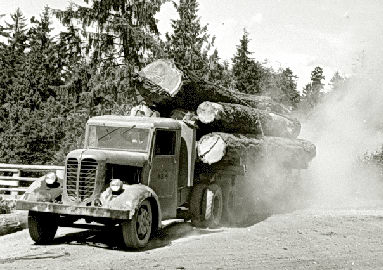
"Loaded Logging Truck at Muir Creek," 1944.
Photo: BC Archives |
|
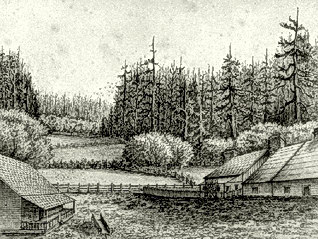
Woodside homestead, 1880
Drawing by I. A. Andrew
By the early decades of the 20th century logging methods had adapted to accomodate
big trees and industrial clearcutting began in earnest. For more than 50 years, huge logs (left) from the
forests at Muir Creek have been trucked out to satisfy the unending demand for wood products, leaving behind a denuded
wasteland. |
|
| |
|
|
|
|
| |
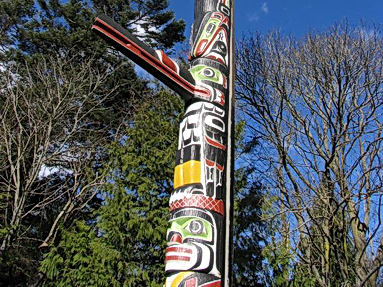
Mungo Martin totem pole, 2008.
Beacon Hill Park, Victoria, BC
The Extermination of Totem Trees In 1955, a 50 m red cedar tree growing at Muir Creek was selected for a totem pole and towed
by tug to Victoria where it was carved by Mungo Martin (1881 - 1962), a Kwakiutl chief and influential artist who
revitalized Northwest Coast carving traditions. The 38.8 m high totem pole was erected in Beacon Hill Park in
Victoria as a tourist attraction and proclaimed by city officials to be "the world's tallest history book"
(right). Today it is difficult to find large enough cedar trees from which to carve totem poles and
Northwest Coast art is threatened. |
|
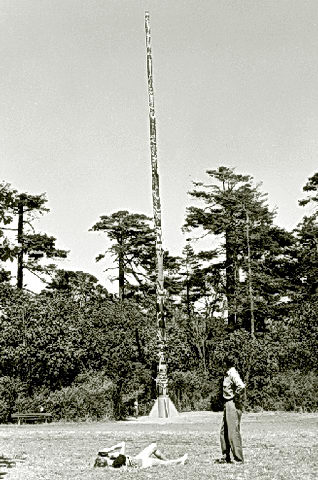
Mungo Martin totem pole, Victoria, 1955.
Photo: BC Archives |
|
| |
|
|
 |
|
| |

Town Pole, Evergreen Mall, Sooke.
Photo: Town of Sooke
The Town Pole of Sooke (above) is located at the Evergreen Mall. Note the size of the
two huge Douglas firs on the right for scale. At the top of the
pole is a larger than life model of a "high rigger," the term for logging industry workers who climbed the
highest trees to harness them as "spar trees" which were then used to clearcut log the forest. Below him is
a logger standing on springboards with his axe deeply embedded in the giant tree. This public sculpture displayed in the
middle of Sooke (right) is a tribute to the origins of this logging industry settler community. Today the
lucrative logging days on Vancouver Island have ended and dubious land transfer schemes are being arranged whereby
logged off forests are subdivided for real estate. MLA John Horgan has condemned this practice:
Tree
Farm Giveaway. |
|
The town of Sooke was incorporated in 1999,
named after the Sooke regional district which in turn took its name from the T’souke people who
were its original inhabitants. Most of the old growth forests in Sooke were logged during the
past century and now the second growth forests are being logged by TimberWest, a company well known
for its unethical logging practices and shady Tree Farm License transactions.
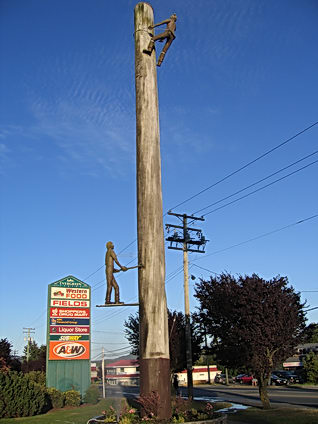
Town Pole, Evergreen Mall, Sooke.
Photo: Karen Wonders |
|
| |
|
|
 |
|
| |
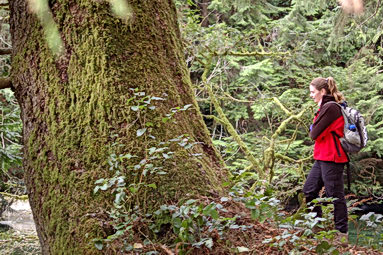
Giant Sitka Spruce, Muir Creek, 2006.
Photo: Muir Creek Protection Society
Three species of salmon (Spring, Coho and Chum) spawn in Muir Creek (right).
The estuary of Muir Creek is a wildlife haven for river otters, mink, bears, eagles, herons,
king fishers and dippers, all which depend on runs of chum, cutthroat and steelhead. This ecosystem
has already been severely degraded by the Arden Gravel Pit. Yet in 2008 BC's Ministry
of Mines approved a large extention of this operation despite b community opposition
and a long record of non compliance with environmental regulations. |
|
TimberWest is profiteering by real estate speculation and after it completes its planned logging of
Muir Creek, the land will be degraded yet further by subdivisions. Because few government regulations exist to protect the
environment and watersheds of local communities, citizens have declared their dedication to preserving the Muir Creek
big trees and to founding a much needed public park to provide ocean access to a beach
well known for its remarkable fossils:
Muir Creek Protection Society.
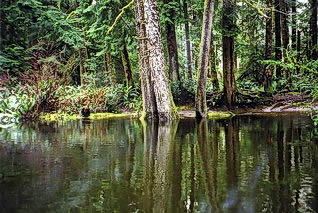
Muir Creek riparian ecosystem, 2008.
Photo: Muir Creek Protection Society |
|
| |
|
|
 |
|
| |
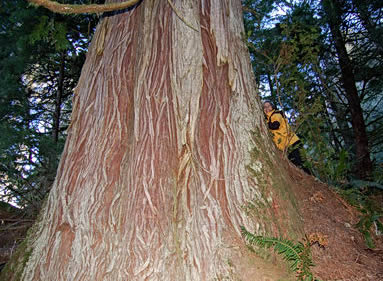
Ancient red cedar, Muir Creek, 2006.
Photo: Muir Creek Protection Society |
|
Private owners of forest lands
like TimberWest claim to be exempt from environmental regulations. Indeed logging corporations
have been able to grab huge sections of profitable forest lands with government compliance.
Rather than protect the forest lands as public domain and address the fundamental issues of
Aboriginal Title, the BC government continues to serve big business and disregard local communities.
Some veteran survivors of industrial logging can still be
found on the banks of Muir Creek. Numerous Sitka spruce trees measure over 6 m; the largest is
almost 8 m. Aboriginal heritage trees include a gigantic western red cedar 9 m (29 ft, 6 in) in
circumference (left). All together, nine of monumental trees at Muir Creek are large enouch to be included
in the BC Big Tree Registry. |
|
| |
|
|
|
|
| |
Muir Creek is one of the few habitats in BC where
the rare and endangered "Warty Jumping Slug" can be found (right). It is indicative of the low
priority placed by the BC government on protection for species of native flora and fauna that no effort is made
to preserve their habitat where it conflicts with industrial resource extraction. "The greatest threat to this species is clearcut logging,
which results in habitat loss, degradation, and fragmentation. Logging alters the quality and quantity of coarse
woody debris used by the Warty Jumping slug for refuge. It isolates populations and restricts gene flow because
this slug is relatively sedentary and has poor dispersal abilities." Right: the Warty Jumping slug is protected:
Species at Risk
(Environment Canada). |
|
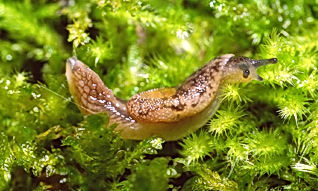
Warty Jumping Slug.
Photo: Kristiina Ovaska |
|
| |
|
|
 |
|
| |
|
|
| |
©
Contact & Credits |
|
| |
|
|
|
|

